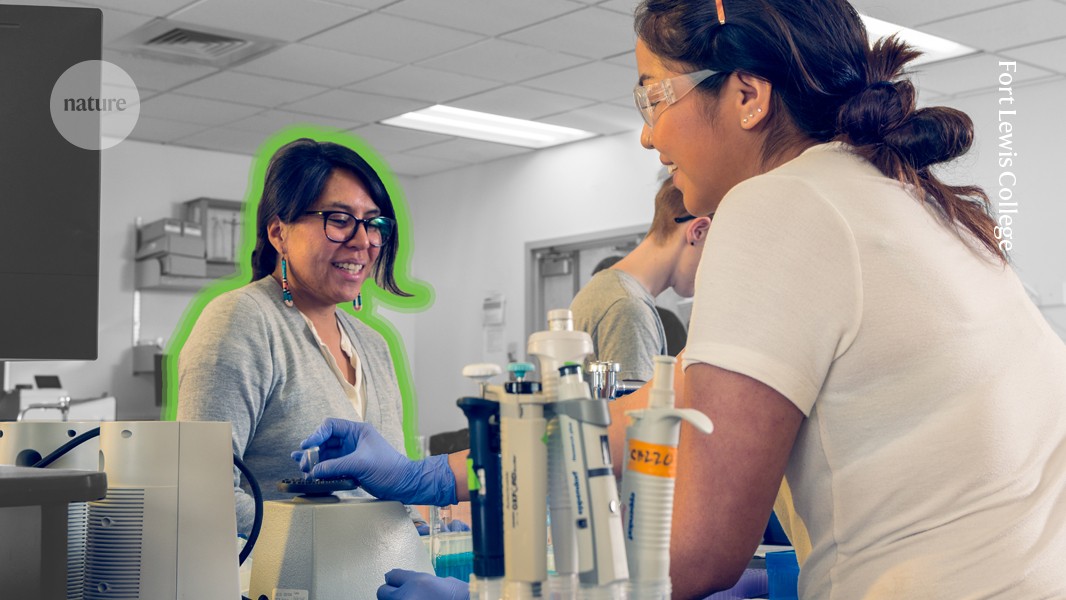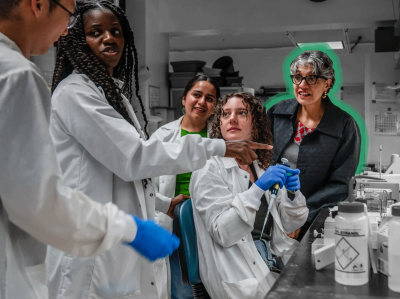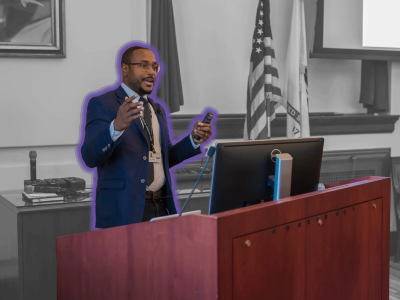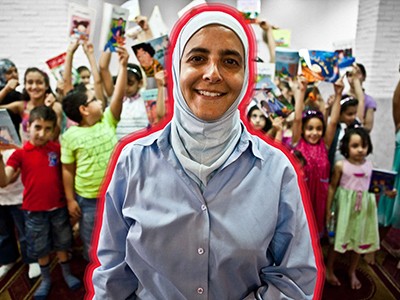So far, 64 undergraduate students at Fort Lewis College in Durango, Colorado, have come home from their first year with new hiking boots, sturdy socks and a hydration kit. They are part of the Fort Lewis Outdoor Equity Group run by Joslynn Lee, an alumna of the university who is now an assistant professor there using DNA sequencing to study how microorganisms function in ecosystems. She launched the programme in 2022 with a US$25,000 grant and has now helped dozens of students from under-represented backgrounds to explore hiking, skiing and snowboarding. In 2019, she began a successful three-year initiative to remove from the campus racially insensitive panels depicting local history.
Leveraging her expertise in computational chemistry and biology, Lee has created undergraduate teaching curricula for studying environmental microbiota that include place-based research, an approach that can incorporate Indigenous viewpoints. In 2023, she was selected as a Kavli Frontiers in Science fellow, a programme for developing leadership potential in early-career scientists.
What is the great passion that has driven you as a scientist?
‘I saw that discrimination wasn’t hearsay or rumours — it really did exist’
As an Indigenous person growing up in Farmington, New Mexico, I learnt traditional values that focus on who we are as people here on Mother Earth, always thinking about community and the environment. For me, it was always, ‘What can I do to help our people?’ or thinking about how to help the environment so that we can sustain our livelihood. Obviously, that was a small world iew, and it wasn’t until I went to grad school that I began thinking on a larger scale. I was passionate about science but also experienced the microaggressions that are directed towards women and people of colour in the sciences. Holding on to the cultural values I was brought up with, both from my Diné (Navajo) side and from my K’awaika (Laguna Pueblo) and Haaku (Acoma Pueblo) background, helped me get through all the difficulties. And it has driven me to think about how to make changes for the health of our environment.
Why do you think it’s important to work for equitable access to outdoor activities such as hiking and skiing?
Outdoor trails have become more inclusive, but that shift was only four or five years ago. Where I live in Durango, there are tons of opportunities. Yet, as a student, I wasn’t able to learn about them easily, and I didn’t have the equipment to hike comfortably, or the knowledge of how to navigate this predominantly white space.
We’re trying to reach a group of students who are interested but don’t know where to start. We’ve done snowshoeing, hiking at higher elevations, mountain biking and a skiing and snowboarding event. We’ve tried to centre all these activities around themes by collaborating with Indigenous student leaders. So, for example, we had a hike to raise awareness of missing and murdered Indigenous people. We haven’t done an event focused on conservation yet, but we do teach folks who participate to Leave No Trace — the ethos of having a minimum impact on wild spaces — and other good outdoor practices.
Who has been your biggest influence or mentor and why?
I’ve had quite a few mentors, but the most impactful person has been Les Sommerville, my undergraduate biochemistry professor and the first person who gave me a research opportunity. He was very careful in thinking of the future. He was always saying, “You should come back to Fort Lewis, you’d make a huge impact.”
‘There’s a lot of privilege masquerading as merit’: why inclusion matters in academia
He took me to my first conference, the American Chemical Society meeting in San Diego, California, when I was an undergraduate. That experience blew open my perspective on science and the scale of current research. He was also very culturally aware and open to learning about my experiences and how to support the decisions I made, even offering support past graduation. He was always very encouraging of students pursuing more education, and he told me there would be more I could do in the future as a scientist with a PhD.
We’ve kept in touch. He’s been one of my mentors and one of my role models for mentoring Indigenous and other students. Now, he’s great at connecting students who are unsure about grad school with me and cultivating a community among our Fort Lewis biochemistry alumni. His support helped me through all the years of graduate school, continuing to today.
Why do you invest time in diversity, equity and inclusion (DEI) and antiracism work?
My drive is to make science a safe, equitable, inclusive space that’s accessible for everyone. The content we teach in chemistry or biochemistry is all in a Western context. I’m trying to work out how we can share the discoveries other people and cultures have made, so science isn’t taught through just one lens.
I wanted to build a curriculum that creates an accessible experience and builds a sense of belonging in science, technology, engineering and mathematics while respecting cultural perspectives. In Western science, humans are organized at the top of systems, whereas my Indigenous world view has interconnectedness at its centre.
When teaching chemistry, I try to include an engaging story. For example, what were the thought processes and experiments used to first identity subatomic particles? There are also Indigenous world views on how we perceive the Big Bang that I share. With Naomi Lee, a biochemist at Northern Arizona University in Flagstaff, I co-wrote The Chemistry and Culture Workbork for the Reformed Experimental Activities (REActivities) programme, a redesigned chemistry curriculum with a more student-driven, inclusive approach. It incorporates Indigenous knowledge in chemistry with laboratory experiments to follow along.
Outside the classroom, I’m interested in finding the unique mentoring styles that serve our students best. The lived experiences I’ve had guide what I share with students and how I bring perspectives to spaces that other people don’t have a chance to share. Maybe I will be able to loosen my DEI and antiracism focus a bit when more faculty members are open-minded, or when the US National Institutes of Health and National Science Foundation are allowing more creativity in grants and when lab spaces become more inclusive. For now, there are some places where I will not give a talk because I don’t think they’re inclusive. My work isn’t going to change them; it has to come from a higher institutional level.
How have you dealt with issues of racism or discrimination personally and professionally?
My mom has always told me to stand up for myself. I take a calm, non-reactive approach, asking people, ‘Why would you say that?’ and ‘What is your knowledge?’ As an undergrad, I faced a lot of comments such as, ‘You get to go to school for free just because you’re Native.’ [Editor’s note: Fort Lewis College was once the site of a forced boarding school for Indigenous children. Today, it is a Native American-serving institution and awards tuition waivers to Native American students.]
I’m a Palestinian scientist building a more inclusive future
People just didn’t know the full background. I would say, ‘Do you understand why this occurs? What’s your knowledge? What are your facts?’ If it was derogatory, I would just point out that it was not a nice thing to say and excuse myself.
As I’ve got older, I reframe things more as teaching moments. People tend to apologize more often this way. But I’ve also learnt not to invest in people who are just racist and aren’t going to change. I ask myself whether this person is willing to learn and reflect. Is it going to be worth my energy?
I’m in a lot of spaces where I’m in the minority. I try not to speak for all groups I represent, but at some point, we’ve got to take a timeout and acknowledge when a comment is inappropriate.
What single thing would you change about the way science is done?
Just slowing down. There are times it feels as if it’s just writing a grant, moving to your next set of experiments, getting some data and writing another grant; always having a paper in publication.
That doesn’t work for all types of institution. I’m at a mainly undergraduate institution. We’re heavy on teaching, but we also do research and mentoring, so projects start to build up. We’re in this academic system where you must publish or demonstrate that your lab is high impact for tenure and promotion — but a high-impact paper takes quite a bit of time. I wish that there wasn’t so much pressure. There are projects I’d love to go back to, but they are not funded at this moment. I’d love to be able to be reflective and take more time to make connections.
What’s one surprising fact about you that only your family knows?
Everyone’s always impressed that I have had two brain surgeries. I had a Chiari malformation, where part of your skull is too small for your brain. When I was diagnosed at age 33, they also found a brain tumour that had to be removed. When I can’t ride roller coasters or ski on a double-black-diamond slope, I tell people it’s because my neurosurgeon wouldn’t be happy about it.





